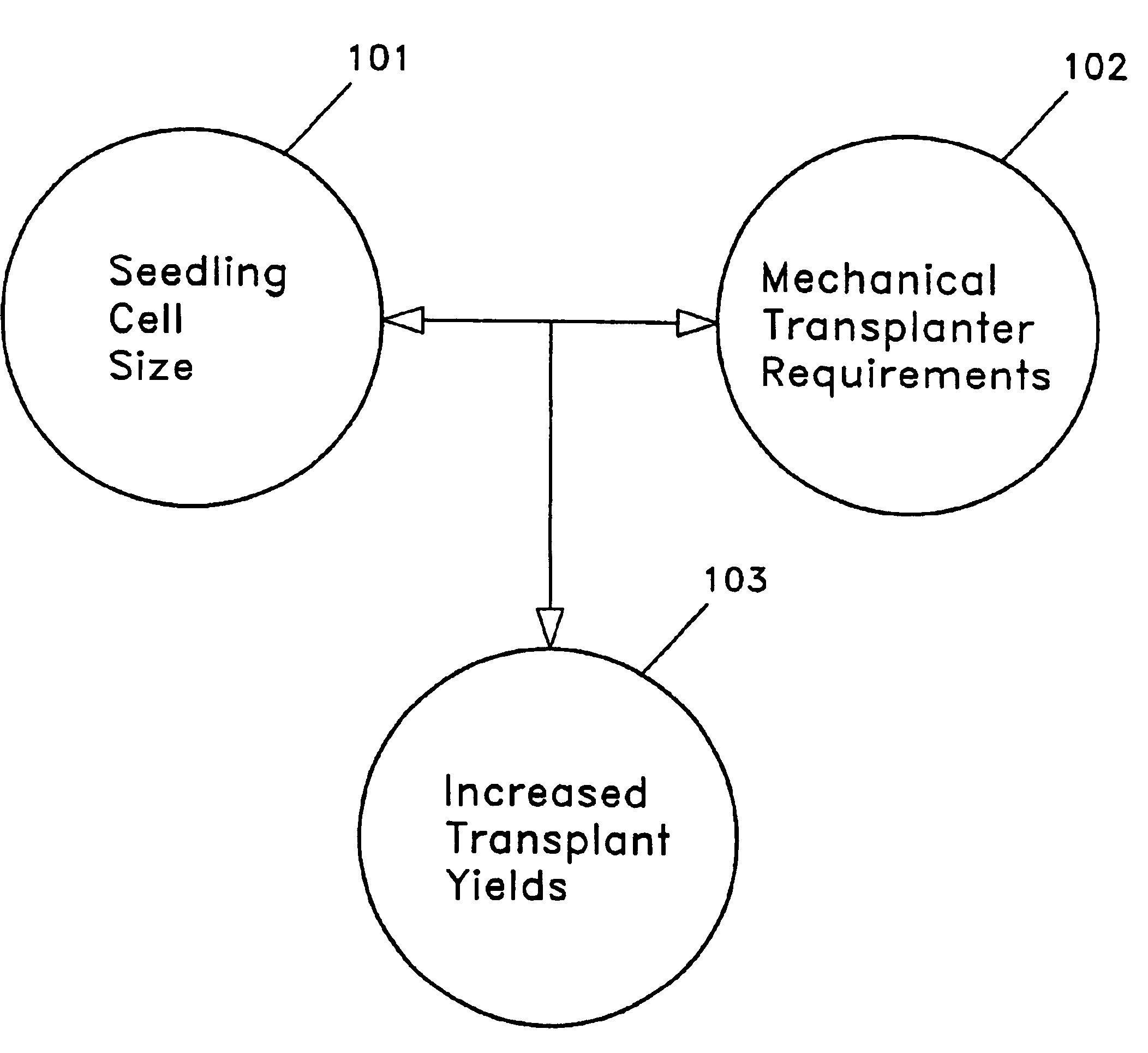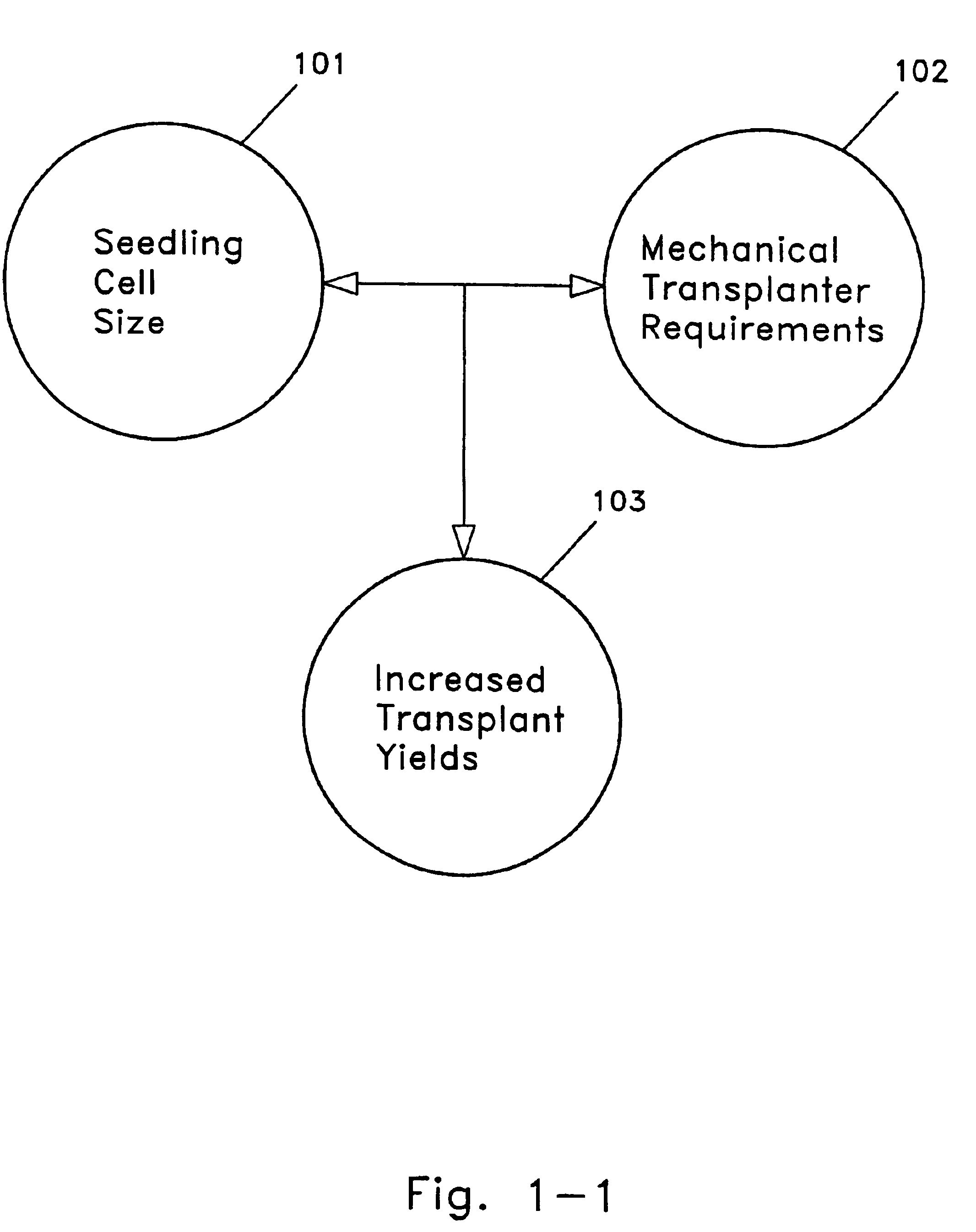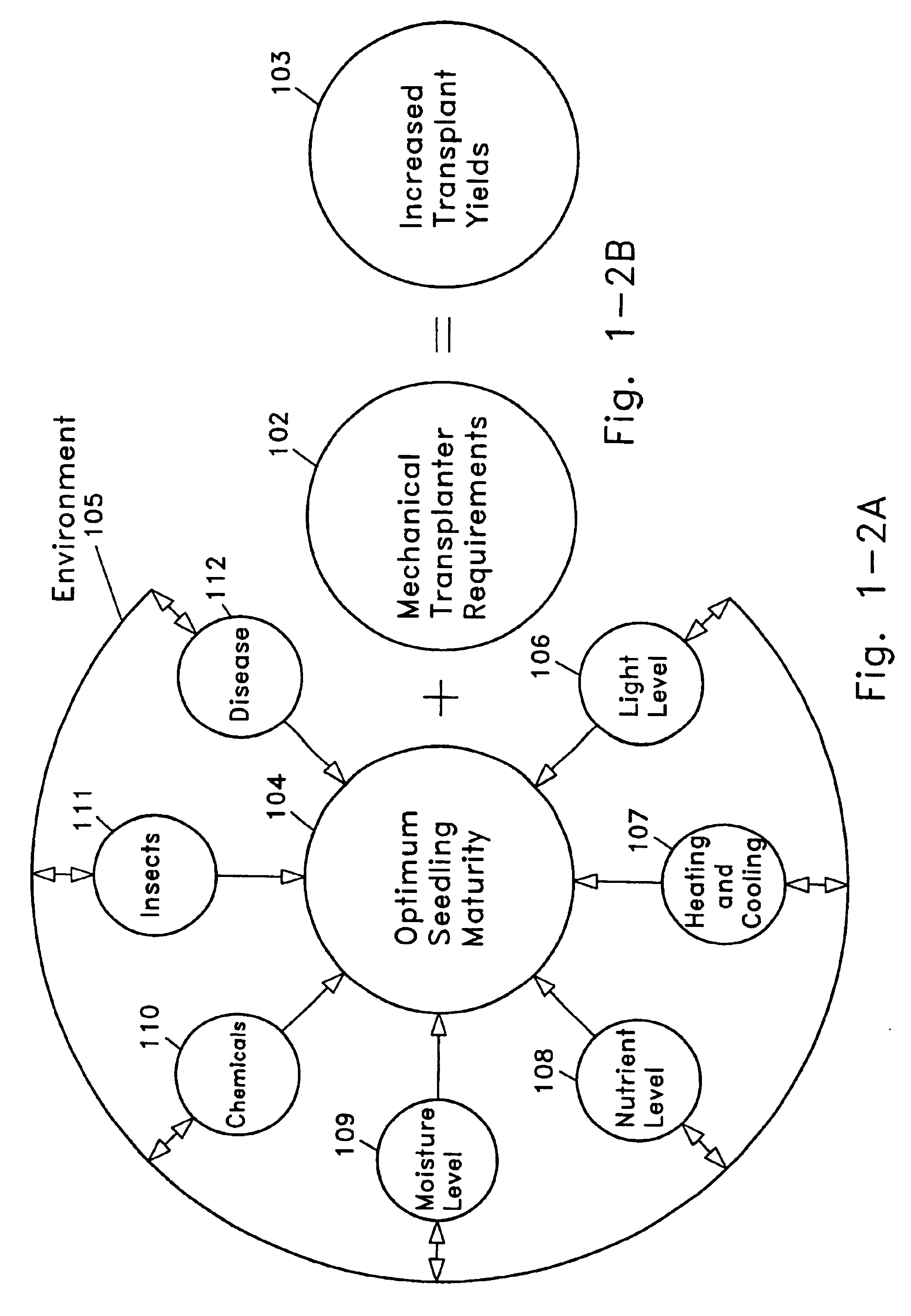This process is labor intensive and therefore expensive.
Since this process of hand transplanting is not economical, several mechanical methods for transplanting the seedlings from the smaller cells to larger containers have been developed.
Some seedlings may have been too small or too large to be successfully transplanted using a mechanical transplanter.
This may have resulted in greenhouse operators purchasing seedlings that cannot be used, thereby decreasing the yields of finished containers to seedlings.
Some seedlings may have been transplanted using this method, but because of mechanical damage to the seedling experienced during the mechanical transplanting process, the seedling later dies.
This may result in greenhouse operators replacing the dead plant by hand.
This can be very labor intensive and cost inefficient.
This reduces the yield of the expected finished containers.
Greenhouse production costs often exceed 70% of the overall product costs.
In addition, while the system of pushing or punching the seedling into the new larger container can allow for a simple transfer from the seedling tray to the larger container or tray, a problem can exist in that there may be several steps that need to be accomplished by hand which slows the process down considerably.
The slower the process, the more inefficient the use of labor.
This can also cause increased production costs.
One problem that greenhouse operators struggle with is that seedling producers have not previously been producing seedlings specifically grown to be transplanted with a mechanical transplanter.
For example, one of the problems with this punch-down method of transfer is that the seedling can often be put under pressure as it is punched down through the seedling tray and into the new larger container's media as shown in U.S. Pat. No. 3,799,078 and U.S. Pat. No. 3,820,480.
This method uses a very small cell for the seedling, which can result in the transfer of an immature seedling with a small root system in a small amount of rooting media.
Because of the extremely small size of the individual cells, the seedlings can often be damaged during the punch out process.
Because of the high-density number of cells per tray, seedling leaves can be damaged because they do not often fit properly or optimally though the very small cell.
This damage to the seedling can provide a wound for disease or insects, which can reduce the vigor of the transplanted plant or even cause death.
The seedling's roots and media may be compressed into the new larger container's media potentially resulting in tearing and crushed roots.
Tom and crushed roots allow disease and insects a point of entry, which may reduce seedling vigor and may lead to death of the seedling in the new, larger container.
Further, the amount of rooting media is often extremely small.
Because of the small amount of media usually available for the seedling to root into, the root system of the seedling is often small and fragile and therefore subject to tearing or damage that may provide a wound entry for disease or reduce the overall root volume available to support the plant.
Seedlings with damaged, diseased roots usually have reduced vigor and increased mortality rates.
All this may require the greenhouse operator to replace the dead plants or discard the container as unsalable.
Small, immature seedlings have a higher mortality rate--often as high as a 10-15% value of increase depending on variety of seedling--which can dramatically reduce the transplant yield and increase production costs.
As can be understood, such tray designs did not allow for optimum seedling development.
Perhaps surprisingly, this can actually be detrimental.
Because of the very high density of individual cells per tray, it can be extremely difficult to sow an individual seed into each individual cell.
It is even more difficult to insure that the sown seed is placed appropriately.
Obviously, cells without seeds cannot be transplanted.
Yet when the tray is used in a mechanical transplanter, the mechanical transplanter does not know that there is no seedling in an individual cell and therefore transplants the empty cell anyway.
This requires the greenhouse operator to patch the missing plant by hand, which is again labor intensive and expensive, or to discard the container as not salable--which is also expensive.
Seeds not sown into the middle of the cell may become damaged by the mechanical transplanter during the transfer process and seedlings germinating and growing on the edge of the individual cell may be subject to more crowding by neighboring cells and more drying because the roots have less media available.
This can cause poor root development and therefore weaker roots.
Usually these weak seedlings die or do not perform to the expectations of the greenhouse operator.
Another problem is that because of the extremely high density of the individual cells in the seedling tray, the individual cells are sometimes not able to maximize the germination potential of seeds that are sown correctly.
This adds additional expense due to increased use of seed, seedling trays, greenhouse space, and labor and overhead to manage that production buffer.
Sometimes the seedling tray and larger container may often not be compatible, resulting in leftover seedlings that may either be thrown away or may need to be manually transplanted.
This may require or economically drive greenhouse operators to either discard the left over seedlings or to discard the finished tray that is not completed causing additional expense in seed, growing media, trays, labor, greenhouse space, and overhead to manage product that will be discarded.
Focusing on the punching process itself, the head of the punch-down device can be too large for the cell dimensions.
It may thereby significantly increase the likelihood that the puncher head will break or crush leaves and or the stem of the seedling being transplanted.
Crushed or broken leaves or stems may allow disease and insects a point of entry which may reduce seedling vigor and may lead to death of the seedling in the new, larger container.
One specific problem can be that the cell size that the seedling is grown in has not been coordinated with the transplanter to maximize transfer from the small cell into a larger container.
This may result in seedling damage because the transplanter cannot successfully transfer the seedling from the small cell without tearing or smashing of seedling stems or leaves.
This tearing or smashing may create a point of entry for disease, or may reduce the vigor of the seedling so it either is stunted or dies in the larger container and thus reduces yield.
Another problem is that the root system may be compressed or torn by pushing or pulling on the seedling as it is transferred.
This compression or tearing may create a point of entry for disease, reduce the capacity of the rooting media to adequately provide moisture and nutrients and reduce the vigor of the seedling so it either is stunted or dies in the larger container.
Another problem can be that the maturity of the seedling is often not factored into the transplanting process.
Seedling producers know that an immature seedling may not transplant successfully if it has an underdeveloped leaf, stem and root system and that an overly mature seedling may not transplant successfully because it may have an overdeveloped leaf, stem and root system.
However, the optimal seedling stage for transplanting based on both cell size and transplanter system has not been considered.
The stress of transplanting from small cells to larger containers has not been previously considered which may result in several problems.
Seedlings may receive unnoticed damage to leaf, stem and roots that may allow disease to enter and reduce overall plant vigor.
The stress of transplanting from the small cell to the larger container is not minimized so the seedling may require a recovery period from transplanting which may then result in increased crop time and additional production costs, therefore, yields can be compromised by seedlings that are not transplanted at the optimum time to better achieve their growth potential whether relative to leaf, stem, or root.
As a result, one problem may be that a customer in Texas with high light levels and warm temperatures would receive the same cuttings as a customer in Montana with low light levels and cool temperatures.
This may create a problem in that the seedlings may not be acclimated to their new environment so transplanting stresses may be increased.
Additionally, the vigor of the seedling may be reduced resulting in stunted or dead plants.
This, of course, may reduce yields.
Another problem can be that the leaf area and leaf type of the seedling may not be coordinated with the mechanical aspect of the transplanting process.
This could result in a significant number of torn or damaged leaves on the seedlings as the transplanter transfers the seedling from the small cell to the larger container.
This tearing or damage of the leaf may create a point of entry for disease, or may reduce the vigor of the seedling by reducing the photosynthesis area so it either is stunted or dies in the larger container.
This may also reduce yields.
A significant problem also can be that the size of the cell may not be coordinated with the seedling leaf type.
This may cause several problems.
Under these large leaves, humidity may increase and light may decrease.
Seedlings with these characteristics may not be successful in the transplanting process.
They may die due to the disease or insects that may have already infected them or, because they may have a weak stem, they may break during the transplanting process or fall over once they are transplanted and there is no longer any support from surrounding seedlings to keep them upright.
This may also reduce yield.
Conversely if a small leaf seedling variety is in too large a cell, the rooting media may dry too quickly because there is not enough leaf area to shade it and evaporation may then be increased.
This may result in seedlings that have weakened root systems due to excessive drying which again, may create a point of entry for disease, or reduce the vigor of the seedling so it may become stunted or may die in the larger container.
Another significant problem can be that cell size may not be coordinated with the seedling type to maximize seedling leaf, stem and root development for optimum transplanting yield.
This may result in seedlings that are stressed because they do not have adequate leaf expansion area and root development area.
When transplanting from the small, incorrect cell size to the larger container occurs, the seedling may either be stunted or die in the larger container.
Transplanting or increased crop time may be necessary which can add to production costs.
It can be difficult for the transplant operator to quickly and easily determine where the next position for the seedling tray is.
As a result the seedling tray may not be in the correct position so the punch heads can either punch the wrong seedlings or punch in a position that has already been punched, so there are no seedlings in that position to be punched down.
Because there are as many as 6 to 14 different positions that the seedling tray needs to be positioned into, the opportunity for operator error is high.
This can reduce transplanter efficiency, which increases labor costs.
These 2 manual clamps can need to be in position so that the seedling tray does not move which could result in changing the position of the punch heads (as described above) or that seedlings could be damaged due to the punch heads tearing or crushed the seedling tray.
This manual step can take additional time for the transplant operator and because the clamps can be small, it can be easy for the transplant operator to apply them incorrectly.
Seedlings that are crushed or torn by the punch heads usually die in the large containers.
Yet another problem can be that the larger container (usually a tray) that is positioned below the seedling tray can have a manual stopper.
If the transplanted seedling is not in the center of the new, larger container, the seedling may root out into the new media incorrectly.
This may reduce seedling vigor and can increase the time it takes to finish the seedling into a salable plant.
 Login to View More
Login to View More  Login to View More
Login to View More 


